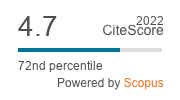Tremorgenic mycotoxicosis can arise from dietary exposure to secondary metabolite products of various fungal species, particularly those from the Penicillium genus. Although general toxin screens often rely on gas chromatography-mass spectrometry (GC/MS) and well-developed mass spectral library databases, two principal representative Penicillium mycotoxins, roquefortine and penitrem A, are unamenable to GC/MS owing to high molecular weights, low volatilities and/or high thermal instabilities. Reliance on GC/MS screens alone could therefore inadvertently result in failure to collect evidence of exposure to such tremorgenic mycotoxins. In this report we describe a newly discovered tremorgenic marker compound (TMC), the presence of which correlates highly with conclusive exposure to Penicillium toxins in explanation of clinical manifestations of tremorgenic mycotoxicosis. According to detailed mass spectral deconvolution, the compound is 210.0892 molecular weight, and amenable to GC/MS whether chemically underivatized or derivatized by methylation or trimethylsilylation. 1D and 2D NMR (nuclear magnetic resonance) studies on the isolated compound determined the TMC to be the Penicillium product terrestric acid, C11H14O4, which matches the molecular formula determined by high resolution mass spectrometry and thus provides an excellent target for assessment of mycotoxicosis by GC/MS.
RESEARCH ARTICLE
A novel chemical marker of tremorgenic mycotoxicosis detected by gas-chromatography/mass-spectrometry
C. Pickard Related information
1Synlab VPG, Unit 8 Temple Point, Bullerthorpe Lane, Leeds, LS15 9JL, United Kingdom.
, J.S. Fortin Related information2Michigan State University College of Veterinary Medicine, Department of Pathobiology & Diagnostic Investigation, Michigan State University, Lansing, MI 48910, USA.
, D. Holmes Related information3Michigan State University, Max T. Rogers NMR Facility, Department of Chemistry, Lansing, MI 48824, USA.
, J.P. Buchweitz Related information2Michigan State University College of Veterinary Medicine, Department of Pathobiology & Diagnostic Investigation, Michigan State University, Lansing, MI 48910, USA.
4Michigan State University Veterinary Diagnostic Laboratory, Toxicology Section, Michigan State University, Lansing, MI 48910; USA.
, A.F. Lehner Related information4Michigan State University Veterinary Diagnostic Laboratory, Toxicology Section, Michigan State University, Lansing, MI 48910; USA.
4Michigan State University Veterinary Diagnostic Laboratory, Toxicology Section, Michigan State University, Lansing, MI 48910; USA.
*Corresponding author: lehnera@msu.
*Corresponding author: lehnera@msu.
World Mycotoxin Journal: 15
(3)- Pages: 223 - 240
Published Online: December 13, 2021
2023 Journal Impact Factor
2.0
source: Journal Impact Factor 2023™ from Clarivate™

Institutional Offers
For institutional orders, please contact [email protected].
Purchase Options
-
P. Battilani and M. Camardo Leggieri
-
F. Xu, R.C. Baker, T.B. Whitaker, H. Luo, Y. Zhao, A. Stevenson, C.J. Boesch and G. Zhang
-
A.O. Aasa, F.F. Fru, O.A. Adelusi, S.A. Oyeyinka and P.B. Njobeh
-
F. Wu
-
V. Ostry
-
V. Ostry
-
R. Bandyopadhyay, A. Ortega-Beltran, A. Akande, C. Mutegi, J. Atehnkeng, L. Kaptoge, A.L. Senghor, B.N. Adhikari and P.J. Cotty
-
A. Logrieco, A. Moretti and M. Solfrizzo
-
G. Schatzmayr and E. Streit
-
B. Grenier and I. Oswald



